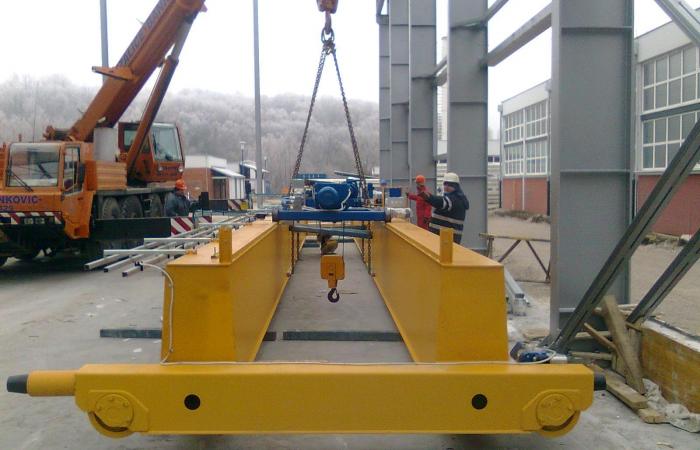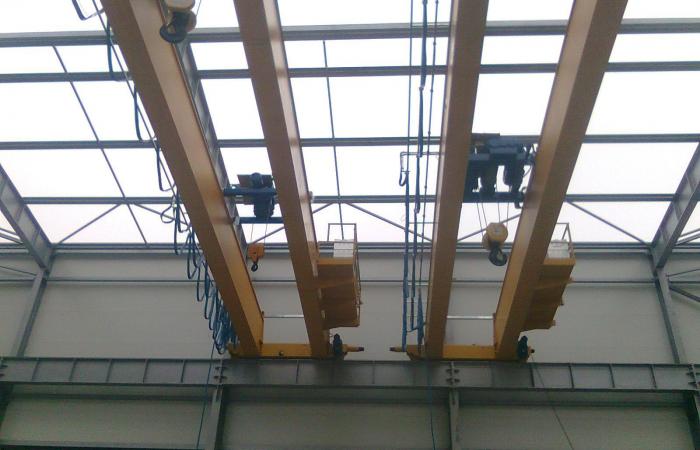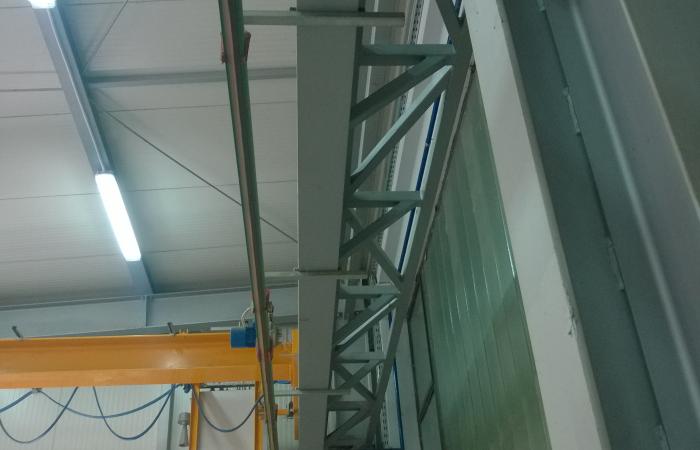Double-girder bridge crane DMD 20 t – 5 t / 16,95 m
PROJECT NAME: Double-girder bridge crane DMD 20 t – 5 t / 16,95 m
INVESTOR: Uniweld machinery Ltd.
LOCATION: Kamanje
YEAR OF PRODUCTION: 2013.
TECHNICAL CHARACTERISTICS:
main hoist auxiliary hoist
- maximum crane capacity: 20 t 5 t
- bridge span: 16,93 m
- maximum lifting height: 9,72 m 9,88 m
- load lifting speed (freq. reg.): 4/0,8 m/min 8/2 m/min
- hoist driving speed (freq. reg.): 20/5 m/min 20/5 m/min
- bridge driving speed (freq. reg.): 30/7,5 m/min
TECHNICAL DESCRIPTION:
For the needs of investor, company Uniweld machinery Ltd., a project was made for the installation of a double-girder bridge crane with a maximum load capacity of 20 t, a bridge span of 16,95 m and a lifting height of approx. 9,5 m. The crane was mounted in the assembly hall of company Uniweld machinery Ltd. in Kamanje on the existing crane tracks on which a double-girder bridge crane of the same characteristics was previously mounted, and the two of them work in pairs.
All working movements of the crane: driving the bridge, driving the hoist and lifting/lowering the load are driven by electric motor drives controlled via frequency converters.
The crane is designed so that the main and auxiliary hoists cannot be loaded at the same time.
The crane is operated from the floor via the radio remote control unit or by means of a suspended control button with reduced voltage in the event of a radio remote control failure. The movement of the suspended control button with reduced voltage along the bridge is independent of the movement of the driving hoists.
Given the conditions and frequency of operation, the crane is classified in II. drive class according to HRN M.D1.020, which roughly corresponds to group M5 according to ISO 4301/1 (or group 2m according to FEM 1.001), for mechanisms.
Double-girder bridge crane consists of:
- steel structure consisting of:
- main girders manufactured as box girders welded from sheet metal with cross-sectional dimensions of 400 x 1000 mm,
- end carriages manufactured as box carriages,
- service platforms,
- main electric driving hoist with a capacity of 20 t,
- auxiliary electric driving hoist with a capacity of 5 t,
- electrical equipment.
The electrical equipment of the crane consists of:
- electric motors for the drive of lifting with a load capacity of 20 t,
- electric motors for the drive of lifting with a load capacity of 5 t,
- electric motor for driving a hoist with a capacity of 20 t,
- electric motor for driving a hoist with a capacity of 5 t,
- two electric motors for driving the bridge,
- main electrical cabinet,
- limit switches of all drives,
- radio remote control system with the possibility of controlling another crane (MASTER-SLAVE option),
- suspended control button with reduced voltage,
- main switches, and
- power and control cables within the crane itself.
Safety devices on both driving hoists, ie on lifting and driving hoist drives are:
- the positions of the permitted maximum winding of the rope on the drum, as well as the minimum are provided by limit switches,
- the overload protection device prevents the lifting of loads heavier than the rated capacity. In the event of an overload, the load must be lowered to put the lifting gear back into operation,
- a cross switch which in the first stage switches off the higher drive speed of the hoist, and in the second stage stops the hoist in the end position,
- a photoelectric sensor that shuts off the winch drive when approaching each other to prevent the winch from colliding.
A cross switch is installed on the end carriage of the crane, which in the first stage switches off the higher speed of the drive of the bridge, and in the second stage it stops the crane in the end position.


